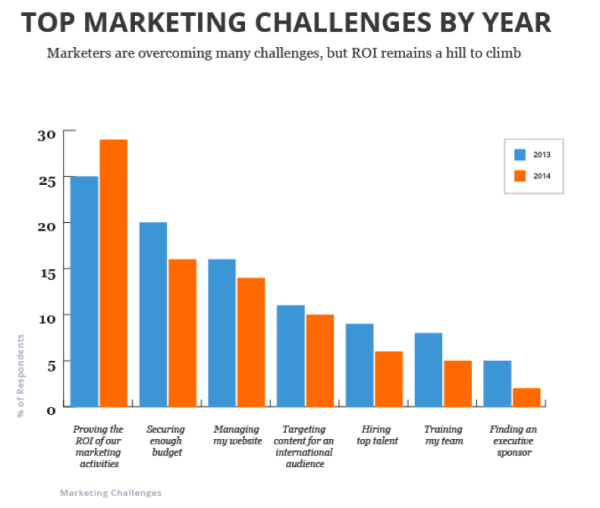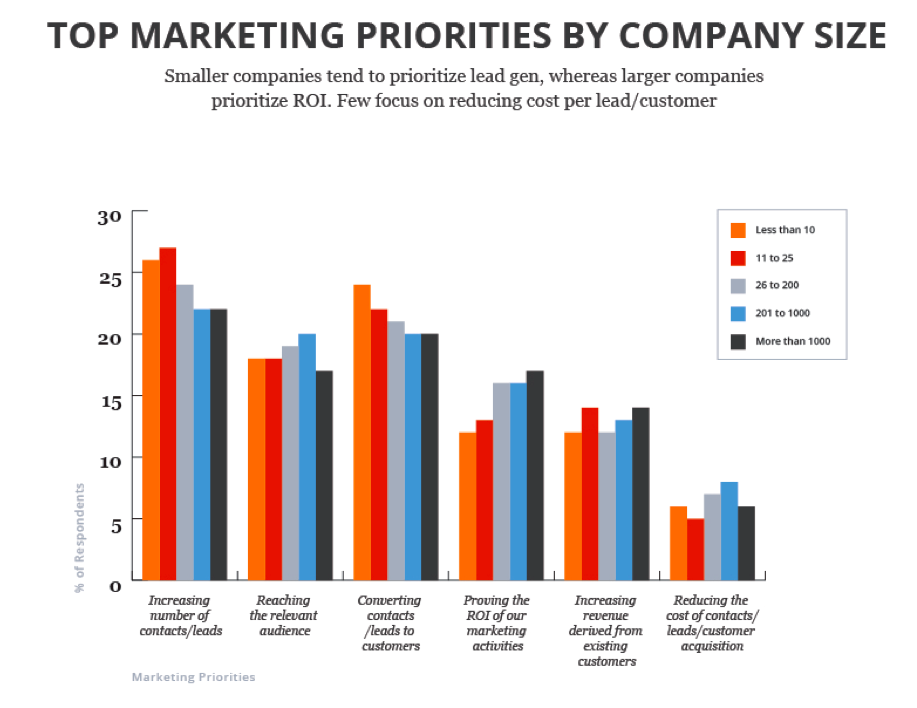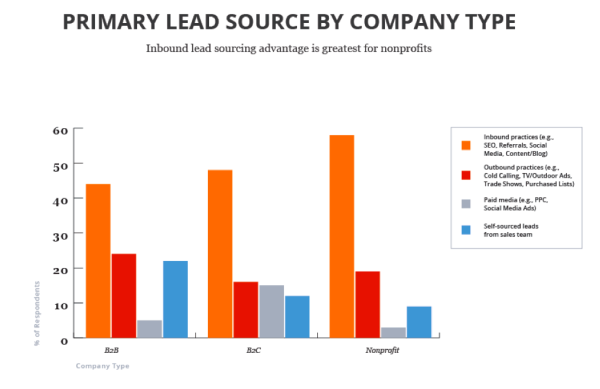
Every year since 2009, HubSpot has released its State of Inbound Marketing report with survey results from thousands of sales and marketing executives. This year, the report spans the globe, with more than 3500 respondents and topics ranging from planning and budgeting for inbound marketing to execution and analysis. Challenges and priorities for this group have changed significantly over the past five years, but one thing remains constant: Those who practice inbound are still passionate about growing their businesses through the inbound methodology. Where are we now? We’re moving in some new directions to leverage data and merge disciplines. Let’s take a look at some of these trends.
#1 – Budget vs. ROI
Marketing budgets are up, to the tune of about 74 percent of B2B companies increasing their budgets in 2014. While the driving force behind marketing budget has always been increasing sales revenues, demonstrating positive ROI has always been a retardent, or at least a question mark. Paradoxically, in this year’s HubSpot survey, marketing executives rank proving ROI as their top challenge while giving ROI a lower priority compared to lead generation and sales conversion efforts.
This is particularly true for small companies (with fewer than 25 employees) focused on building inbound marketing programs and increasing traffic and leads and less concerned with proving the viability of inbound. Marketing departments in larger companies are generally more accountable for their budgets and results and compete with other parts of the organization in regular budget reviews. Regardless of company size, it remains difficult to demonstrate ROI if Sales and Marketing aren’t well aligned in terms of goals, processes and data. Then there’s actually measuring ROI. While HubSpot is creating easier ways for linking marketing activities to revenues through its CRM and Analytics, inbound marketers may not yet have the knowledge or experience to put best practices to use.
Actions you can take now:
- Gain a solid understanding of how marketers analyze ROI
- Find out how to use HubSpot tools to measure ROI
Why Do Marketers Still Argue About Inbound vs. Outbound?
It’s kind of crazy, really. Half of those surveyed rank inbound as their primary lead source, while all other sources (paid media, cold calling, trade shows, etc.) combined are at 42 percent on average. The advantage of inbound over outbound widens as you go from B2B to B2C and finally to nonprofits. The State of Inbound data also shows that inbound is no longer a small company thing. Inbound tactics such as blogs, SEO, social media and opt-in email marketing exceed their outbound counterparts in importance by a large margin in both small and large companies.
I think where we are today is confusing to many marketers. It’s fair to say inbound has done a lot more than gain a foothold across the spectrum of company sizes and industries. While inbound caught on with SMBs, large brands and manufacturers are getting on board quickly these days. What’s interesting is that the role of outbound marketing has also changed. Today, the most effective brand awareness and lead generation campaigns leverage all kinds of media, be it owned, earned and paid channels to reach highly targeted audiences and attract them with relevant or entertaining content. It’s no longer a question of inbound versus outbound. Now we’re using both in a sensible way to attract, convert, persuade and support our customers. The inbound methodology and HubSpot tools allow us to measure the results from all content and distribution channels and make better decisions about what works and what doesn’t. This also goes to proving marketing ROI.
Actions you can take now:
- Think about how your company or institution does its marketing—how can you leverage both inbound and outbound best practices to improve results?
- Read about how HubSpot customers are leveraging inbound marketing.
There’s Surprisingly Little Difference Between B2B and B2C
You might think inbound marketing is still a B2B thing, while B2C companies still focus on advertising. While it’s still true there are more B2B companies using inbound than B2C companies, what’s surprising is they use similar approaches. Yes, B2C spending on advertising still dwarfs B2B spending, but those companies that employ inbound don’t differ that much in how they execute inbound. B2C companies use more interactive content, while B2B companies use more webinars and other thought leadership content. That’s about it for differences.
Actions you can take now:
- Consider that inbound agencies may be a better fit for B2C than you may have thought
- Stop thinking about B2B vs. B2C and start focusing on H2H
The Larger Trend—Customer Happiness
HubSpot has learned a lot and continues to grow and prosper because it pays attention to its own data. The State of Inbound Report for 2014 is a great resource for HubSpot, and for all of us, to understand what matters most to customers and to make moves to make them happier. ROI is a big concern, and we’re getting there in terms of measuring it directly. Marketers are also learning how to better understand the content preferences and preferred channels of their customers and use a combination of inbound and targeted outbound media to satisfy their needs. We’re also learning that inbound is no longer a tactic nor is it a philosophy to be debated. Inbound is a way of life for more marketers and their customers now, and the more we share and discuss reports like State of Inbound, the better we will be at our jobs.



